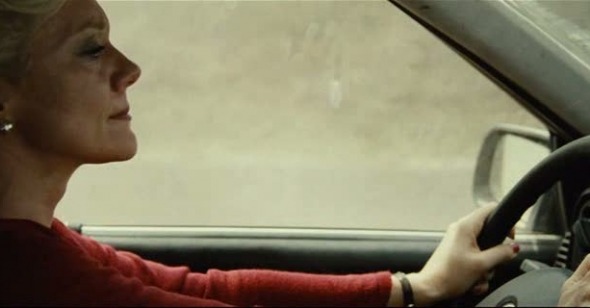After I Forget
By Eric Hynes
The Headless Woman
Dir. Lucrecia Martel, Argentina, Strand Releasing
You’ve seen this empty canal before. Some boys and a dog were running around here, across the street and into it, just a few minutes ago. But you’re not prepared, five minutes into The Headless Woman, with a sunny pop song on the car radio, for the protagonist to hit something. Yet you’ll spend the rest of the film making sense of what happened here, of what you’ve seen and not seen. In the films of Lucrecia Martel you’re challenged to pay attention well before you’re ready, to play catch-up, figuring out who’s related to whom and what is relevant. But as with the protagonist’s subsequent disorientation, your heightened yet bewildered state isn’t a set-up or effect—it’s the point. Martel sharpens your senses—and celebrates and rewards them—while compelling you to distrust them.
In each of Martel’s first three features, a mysterious incident confounds characters and viewer alike, setting a tone that the Argentine director sustains yet also narratively subverts. In La Ciénaga a woman falls onto her wine glass as drunk swimsuited houseguests fail to notice or care about the bloody mess; in The Holy Girl a man presses himself sexually against an impressionable young woman in a crowd; and in The Headless Woman, Martel’s latest knockout, Vero (Maria Onetto) hits something on the road, reacts strangely, then forgets herself. Martel reinforces disorientation by pairing shallow-focus close-ups with episodic narrative; hers are meandering stories presented as visual suspense. Although Vero’s gradual recovery of self and memory serves as Martel’s clearest through-line to date, dramatic resolution remains a low priority. At any moment there can be revelation, but confounding moments are destined to follow. Minor clarifications only deepen the major mysteries of consciousness and perception.
Vero makes for a suitably fascinating and enervating conduit in The Headless Woman. With regal calm beneath a nest of dyed blonde hair (a playful nod to Vertigo), Vero carries her beauty and class with comfort and easy entitlement. She’s a dentist, wife and mother, but considering how long it takes for her co-workers and family to notice her altered state, not a particularly engaged one. She’s captivating but passive, sensitive and callous, wary and childlike. She fights for the truth of her experience only to settle for willful ambivalence. During the accident sequence—a three-minute master class in framing, editing, and sound—Vero reveals herself in concentrated form. After she is stunned by the impact, her first movement, after stopping the car, is to collect and replace her sunglasses. Now inappropriately poised, she resumes driving while looking at a motionless mass—a dog?—receding in the rearview. She soon starts to cry, stops the car and gets out, and escapes beyond the frame. Later, as she rediscovers herself and recalls these events, she’ll cycle through more deliberated versions of these impulses and emotions. Crisis begets both terror and liberation, which leads to flight, the privilege of safety, and bounded anxiety. She remains opaque, the camera honoring her interiority while mining her face for the momentous.
Martel’s consciousness about race and class always seems subordinate but is sneakily central. All three of her films are told from the vantage of relative white power, with Argentine natives literally supporting these characters in household service positions. Martel’s approach to class in The Headless Woman is both more subtle and forceful. Fewer racist complaints about filthy, shady “Indians” are heard than in La Ciénaga and The Holy Girl, but Vero’s entire existence depends on and is restored by privilege. A young boy whose corpse is found clogging the canals—Vero’s victim?—remains unidentified while Vero’s identity is exhaustively retraced. Even her guilt (itself a privileged emotion), though it prompts her to small generosities toward house staff and day laborers, assumes an interchangeability of the underclass. Martel’s shooting style reflects this as well, keeping Vero’s face (and by extension her psychology) in tight focus while others—gardeners, maids, cooks—move about within the haze of negative space. Yet Vero isn’t just a cover for subtextual preoccupations; Martel cares how the world looks from those amnesic eyes. Before she knows who or where she is, an army of attendants flurry about and scare the daylights out of her. With context lost they are literally aliens in her home, moving freely, wielding knives, invading space. Her perception has been made strange but true.
While such accommodations aren’t hard for Vero to relearn to accept, the limitations of being a woman are another matter entirely. Now that she’s mentally, if only temporarily, compromised, Vero’s husband and cousin (another of Martel’s ambiguously amorous family relations) are eager to take charge and whisk the accident away, as well as whatever autonomy she knew before or since. They deny the truth of her experience but give her a cover. She’s the fainter who’s caught, coddled, and controlled; she’s kept safe, but at a cost. “Nothing happened,” they assure her, and the horror is watching Vero accept the easy, life-negating lie as truth. Her husband (Cesar Bordon) later assures her that the dented car—the proof that something happened—can be fixed. “It’s nothing,” he says. “They hammer it a little from the inside.”
